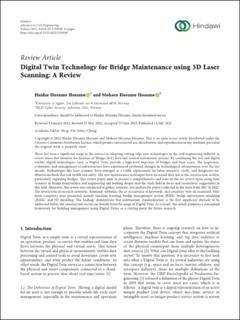| dc.description.abstract | There has been a significant surge in the interest in adopting cutting-edge new technologies in the civil engineering industry in recent times that monitor the Internet of Things (IoT) data and control automation systems. By combining the real and digital worlds, digital technologies, such as Digital Twin, provide a high-level depiction of bridges and their assets. The inspection, evaluation, and management of infrastructure have experienced profound changes in technological advancement over the last decade. Technologies like laser scanners have emerged as a viable replacement for labor-intensive, costly, and dangerous traditional methods that risk health and safety. The new maintenance techniques have increased their use in the construction section, particularly regarding bridges. This review paper aims to present a comprehensive and state-of-the-art review upon using laser scanners in bridge maintenance and engineering and looking deeper into the study field in focus and researchers’ suggestions in this field. Moreover, the review was conducted to gather, evaluate, and analyze the papers collected in the years from 2017 to 2022. The interaction of research networks, dominant subfields, the co-occurrence of keywords, and countries were all examined. Four main categories were presented, namely machine learning, bridge management system (BMS), bridge information modeling (BrIM), and 3D modeling. The findings demonstrate that information standardization is the first significant obstacle to be addressed before the construction sector can benefit from the usage of Digital Twin. As a result, this article proposes a conceptual framework for building management using Digital Twins as a starting point for future research. | en_US |

